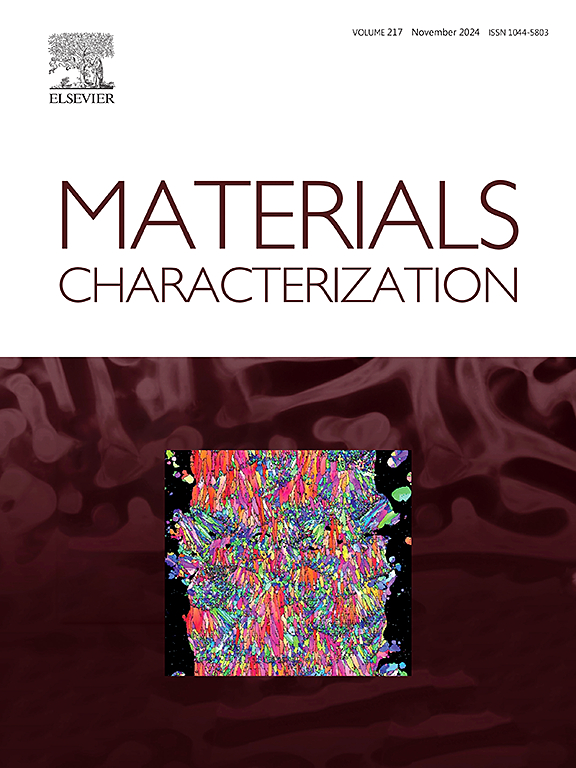Dynamic precipitation behavior and recrystallization mechanism during hot deformation of 7E33 aluminum alloy
IF 5.5
2区 材料科学
Q1 MATERIALS SCIENCE, CHARACTERIZATION & TESTING
引用次数: 0
Abstract
The 7E33 aluminum alloy was engineered through microalloying conventional 7xxx series alloys with Er and Mn. The evolution of its microstructure during hot working directly affects the final product's mechanical properties. The hot deformation behavior of this alloy was investigated under deformation temperatures ranging from 350 °C to 500 °C and strain rates from 0.01 s−1 to 10 s−1 by isothermal compression tests in this study. Furthermore, an in-depth analysis was conducted on the microstructural evolution during the deformation process. The results show that the peak flow stress increased with decreasing deformation temperature and increasing strain rate. The strain-compensated Arrhenius constitutive equation was established based on the true stress-strain curve, demonstrating a correlation coefficient of 0.990 and an average absolute relative error of 3.842 %. Microstructural analysis demonstrated that the high-angle grain boundary (HAGBs) proportion was observed to first increase and then decrease with rising deformation temperature at a strain rate of 0.01 s−1. A maximum HAGBs fraction of 59.4 % was achieved at 400 °C. Some η-phase particles dissolve, some growth from 8 nm to 30 nm at 400 °C. When the temperature increased to 500 °C, η-phase re-precipitation was observed, characterized by an increase in particle number and a reduction in particle size to 3 nm. The pinning effect on dislocations and grain boundaries was significantly enhanced, resulting in a corresponding suppression of dynamic recrystallization. At 10 s−1 and 450 °C, during the hot deformation, dislocations were aggregated to form a “stepped” structure, which could emit dislocations and further form dislocation networks. The dislocation networks ultimately evolve into subgrain boundaries. Furthermore, discontinuous dynamic recrystallization was significantly inhibited by an increase in deformation temperature, while continuous dynamic recrystallization was effectively suppressed by an elevation in strain rate.
7E33铝合金热变形动态析出行为及再结晶机理
7E33铝合金是通过将常规7xxx系列合金与Er和Mn微合金化而设计的。热加工过程中其组织的演变直接影响到最终产品的力学性能。通过等温压缩试验,研究了该合金在变形温度为350℃~ 500℃,应变速率为0.01 s−1 ~ 10 s−1的条件下的热变形行为。并对变形过程中的微观组织演变进行了深入分析。结果表明:随着变形温度的降低和应变速率的增大,峰值流变应力增大;基于真应力-应变曲线建立应变补偿的Arrhenius本构方程,相关系数为0.990,平均绝对相对误差为3.842%。显微组织分析表明,在应变速率为0.01 s−1时,随着变形温度的升高,高角晶界(HAGBs)比例先增大后减小。在400℃时,HAGBs的最大分数为59.4%。在400℃下,一些η相颗粒溶解,一些从8 nm生长到30 nm。当温度升高到500℃时,观察到η相再析出,其特征是颗粒数量增加,颗粒尺寸减小到3 nm。钉住对位错和晶界的影响显著增强,从而抑制了动态再结晶。在10 s−1和450℃时,在热变形过程中,位错聚集形成“阶梯式”结构,从而产生位错并进一步形成位错网络。位错网络最终演变成亚晶界。变形温度的升高可显著抑制非连续动态再结晶,而应变速率的升高可有效抑制连续动态再结晶。
本文章由计算机程序翻译,如有差异,请以英文原文为准。
求助全文
约1分钟内获得全文
求助全文
来源期刊

Materials Characterization
工程技术-材料科学:表征与测试
CiteScore
7.60
自引率
8.50%
发文量
746
审稿时长
36 days
期刊介绍:
Materials Characterization features original articles and state-of-the-art reviews on theoretical and practical aspects of the structure and behaviour of materials.
The Journal focuses on all characterization techniques, including all forms of microscopy (light, electron, acoustic, etc.,) and analysis (especially microanalysis and surface analytical techniques). Developments in both this wide range of techniques and their application to the quantification of the microstructure of materials are essential facets of the Journal.
The Journal provides the Materials Scientist/Engineer with up-to-date information on many types of materials with an underlying theme of explaining the behavior of materials using novel approaches. Materials covered by the journal include:
Metals & Alloys
Ceramics
Nanomaterials
Biomedical materials
Optical materials
Composites
Natural Materials.
 求助内容:
求助内容: 应助结果提醒方式:
应助结果提醒方式:


